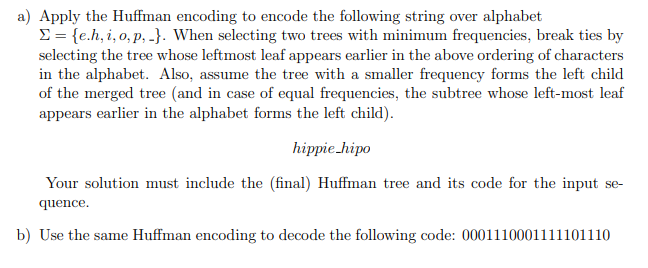a) Apply the Huffman encoding to encode the following string over alphabet = {e.h, i, o,p..}. When selecting two trees with minimum frequencies, break ties by selecting the tree whose leftmost leaf appears earlier in the above ordering of characters in the alphabet. Also, assume the tree with a smaller frequency forms the left child of the merged tree (and in case of equal frequencies, the subtree whose left-most leaf appears earlier in the alphabet forms the left child). hippie hipo Your solution must include the (final) Huffman tree and its code for the input se- quence. b) Use the same Huffman encoding to decode the following code: 0001110001111101110
a) Apply the Huffman encoding to encode the following string over alphabet = {e.h, i, o,p..}. When selecting two trees with minimum frequencies, break ties by selecting the tree whose leftmost leaf appears earlier in the above ordering of characters in the alphabet. Also, assume the tree with a smaller frequency forms the left child of the merged tree (and in case of equal frequencies, the subtree whose left-most leaf appears earlier in the alphabet forms the left child). hippie hipo Your solution must include the (final) Huffman tree and its code for the input se- quence. b) Use the same Huffman encoding to decode the following code: 0001110001111101110
Computer Networking: A Top-Down Approach (7th Edition)
7th Edition
ISBN:9780133594140
Author:James Kurose, Keith Ross
Publisher:James Kurose, Keith Ross
Chapter1: Computer Networks And The Internet
Section: Chapter Questions
Problem R1RQ: What is the difference between a host and an end system? List several different types of end...
Related questions
Question
100%

Transcribed Image Text:a) Apply the Huffman encoding to encode the following string over alphabet
= {e.h, i, o,p,-}. When selecting two trees with minimum frequencies, break ties by
selecting the tree whose leftmost leaf appears earlier in the above ordering of characters
in the alphabet. Also, assume the tree with a smaller frequency forms the left child
of the merged tree (and in case of equal frequencies, the subtree whose left-most leaf
appears earlier in the alphabet forms the left child).
hippie hipo
Your solution must include the (final) Huffman tree and its code for the input se-
quence.
b) Use the same Huffman encoding to decode the following code: 0001110001111101110
Expert Solution
This question has been solved!
Explore an expertly crafted, step-by-step solution for a thorough understanding of key concepts.
This is a popular solution!
Trending now
This is a popular solution!
Step by step
Solved in 4 steps with 2 images

Recommended textbooks for you

Computer Networking: A Top-Down Approach (7th Edi…
Computer Engineering
ISBN:
9780133594140
Author:
James Kurose, Keith Ross
Publisher:
PEARSON

Computer Organization and Design MIPS Edition, Fi…
Computer Engineering
ISBN:
9780124077263
Author:
David A. Patterson, John L. Hennessy
Publisher:
Elsevier Science

Network+ Guide to Networks (MindTap Course List)
Computer Engineering
ISBN:
9781337569330
Author:
Jill West, Tamara Dean, Jean Andrews
Publisher:
Cengage Learning

Computer Networking: A Top-Down Approach (7th Edi…
Computer Engineering
ISBN:
9780133594140
Author:
James Kurose, Keith Ross
Publisher:
PEARSON

Computer Organization and Design MIPS Edition, Fi…
Computer Engineering
ISBN:
9780124077263
Author:
David A. Patterson, John L. Hennessy
Publisher:
Elsevier Science

Network+ Guide to Networks (MindTap Course List)
Computer Engineering
ISBN:
9781337569330
Author:
Jill West, Tamara Dean, Jean Andrews
Publisher:
Cengage Learning

Concepts of Database Management
Computer Engineering
ISBN:
9781337093422
Author:
Joy L. Starks, Philip J. Pratt, Mary Z. Last
Publisher:
Cengage Learning

Prelude to Programming
Computer Engineering
ISBN:
9780133750423
Author:
VENIT, Stewart
Publisher:
Pearson Education

Sc Business Data Communications and Networking, T…
Computer Engineering
ISBN:
9781119368830
Author:
FITZGERALD
Publisher:
WILEY